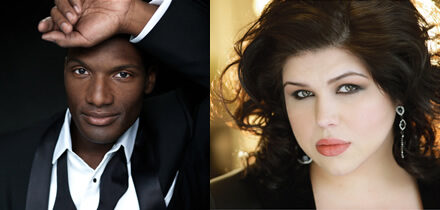Chamber Music Wilmington devoted its first concert of the 2012-13 Season to works of Johann Sebastian Bach. Titled “Celebrating Bach,” this was the first such program given by the group in its fifteen-plus years of performing. The concert was a landmark for Chamber Music Wilmington in another way: it was their first event for which Beckwith Recital Hall was sold out. The quality of the concert mirrored the festive atmosphere of this success.
The first music on the program consisted of two movements from Sonata No. 5 for flute, S. 1034. The splendid flutist Nicolas Duchamp was the soloist. He played the third movement andante with beautifully shaped phrases and rich tone. The finely nuanced long lines sounded effortless and his tasteful vibrato helped give the melodies a wonderful full sonority. Barbara McKenzie accompanied at the piano with quiet delicate sound and attractive articulation of the left hand line. It was a bit odd, however, that with a harpsichord present on the stage the piano was used for this piece instead. This lovely pastoral was followed by the energetic, almost vehement allegro of the fourth movement. At this high energy level, Mr. Duchamp’s phrasing was a model of shape and poise.
The third movement Gavotte en rondeau, from Partita No. 3 for violin, S. 1006, was played next by Adela Peña. The brief selection was given a finely phrased treatment with an attractive dancing quality.
Evidently intended to give the various performers an opportunity to be showcased, these excerpts of pieces were less than ideal from a programming standpoint. That was balanced by the first of the two works which anchored the program, Brandenburg Concerto No. 5. This brought the fine harpsichord soloist Andrew Willis to the stage. Together with a string quartet and Mr. Duchamp, the small ensemble had a clean sound which brought out Bach’s luminous polyphony. The dialogue between flute and violin was finely drawn and the rhythm was propelled energetically. An especially wonderful passage was the anticipatory fade out into the harpsichord cadenza. Mr. Willis brought this virtuoso display to a strong climax, while also treating the brilliant solo to rather strong rubato which sometimes held back forward motion.
The second movement was a beautiful duet between flute and violin. Here nonetheless, the clarity of phrasing was not always fully sustained. One factor was Mr. Willis’ frequent breaking of chords between the hands, which restrained the natural flow of the melodic lines and the rhythm. The ending, however, carried a wonderful hush. The vigorous third movement brought an outgoing character which also could have used more dynamism, perhaps with a somewhat quicker tempo or more emphasis on the forte end of the spectrum. The delightful movement, played by every performer with visible energy and engagement, came together particularly well at the end.
Two works followed the intermission. First was another soloist showcase, an aria from Cantata No. 100, “Was Gott tut, das ist wohlgetan” (What God does is as it should be). Nancy King was the soprano soloist and brought a rich, almost contralto sound to her part. Fine phrasing and tone, clear diction, and rather strong vibrato characterized her rendering of this brief, melodically exquisite aria. The one drawback was that the accompanying ensemble was on the loud side; too heavy for the beauty of the interwoven voice and flute to come through transparently. The piece made an impression however, partly for being the only example of Bach’s deeply spiritual religious music on the program. (Full disclosure: the writer is a colleague of Ms. King at UNC Wilmington.)
Bringing the evening to an exciting close was the harpsichord concerto No. 1 in D minor, S, 1052. Barbara McKenzie was the solo pianist, and again one wondered at the choice of piano over harpsichord for this performance. That said, the first movement had a fine vehemence, if also some slacker moments. Ms. McKenzie’s articulation was always clear and clean, except perhaps in the cadenza, where she used more pedal. At its best this movement had a visceral quality which expressed the passion Bach often brought to his utterances in the minor mode.
The second movement was well-phrased by the pianist, though more passion in the melodic treatment would have been welcome. The ending was especially beautiful. The third movement was propulsive and exciting. The energy was sustained here to bring the concert to a rousing conclusion and cap a fine celebration of one of music’s supreme masters.











